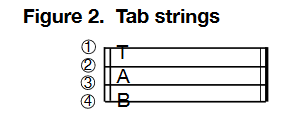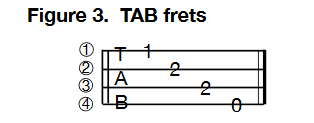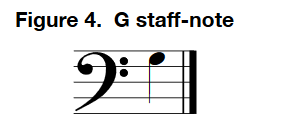The Whole Truth About Bass TAB
Webster’s defines tablatureas "an obsolete form of music notation...". Boy, would he be surprised to discover that TAB has again
become the preferred method of musical notation for bass players in the 21st century.
Why is that?
The simple answer is, it’s so easy! However, if the "whole truth" about TAB were known, its popularity would probably diminish. To
understand this more clearly, let’s go back in time when sound was thought of as being isotonic.
To the ancient Greeks, iso (isos) meant "identical" and tonos (tonic) meant "sound", therefore, isotonic meant "identical sound".
In other words, isotonic is "one sound with one location or sound source”. In the 7th century B.C. this appeared logical, especially to a "bass
player" of that time, the “lyre” player. Figure 1.

The lyre is a small stringed instrument of the harp family which dates back to the ancient Egyptians. It was thought to be isotonic, that
is, to produce only one sound for each string, or said another way, the sound and the string were identical. Here’s an interesting fact:
words sung to the accompaniment of the lyre were called lyrics.
Amazingly, this “isotonic perception" of sound did not change until Pythagoras discovered harmonics in the 6th century B.C.. Simply stated,
harmonicsare "multiple sounds produced on one string". Intervals are the "distance between those sounds", and unison is the same sound
(identical sounds) in two or more locations or sound sources. Notice that "iso" is in the middle of "unison"! As we have previously learned,
unison also means "one sound" from the Latin: uni (one) and sonus(sound). Remember, Romans after the Greeks. Let’s think of it this way, the
piano, being an extension of the lyre, is 100% isotonic, it can not play unison! There is only one sound for each piano key and no two keys
can produce the same sound. The bass however, is almost 100% unison. To see this more clearly, let's look at the sound notation system called TAB or tablature.
The system of bass tablature used today is a combination of 16th century French, Italian and Spanish lute notation systems. TAB comes from "tabula",
which is Latin for "table or tablet" upon which you notate or tabulate. Here’s Webster's definition of tablature: "an obsolete form of music notation used for
string instruments in which the horizontal lines symbolize the strings, and the numbers on the lines symbolize the frets.
Figures 2 and 3.


Figure 3 presents TAB as an "isotonic event", one sound with one fret location, and it is this isotonic TAB view that has enabled tablature to
gain its present day popularity. However, if TAB is presented as the "unison event" that it most often is, one sound with two or more string and
fret locations, the "easiness" of TAB quickly disappears! Let’s illustrate a "G staff-note in the bass clef", and then show its "one sound" as "multiple unison TAB"
string and fret locations. Figures 4 and 5.


Now, while it’s true that the vast majority of the bass fretboard "sounds in unison", it does have a few isotonic sound locations. Figure 6.

The following is a simple melody (Jingle Bells) written in "staff-notes" and illustrated in both isotonic TAB and unison TAB. Figures 7 and 8.

Do you think that anyone would prefer TAB if it was presented as unison TAB? Probably not. The point is, isotonic TAB is easy because
it shows only "one path" through the sounds on the fretboard, when in fact there are "many paths" for the same identical sounds! This is significant, because
where you place the sounds on the fretboard has tremendous consequences on your technique (skill and ability). In other words, you can place sounds
on the fretboard in such a way that it is impossible to play them, or, you can place those same sounds in different locations and "shred"!
Till next time, have some TAB fun, now matter what path you take...I’ll be listening.
Return to Intermediate Lessons